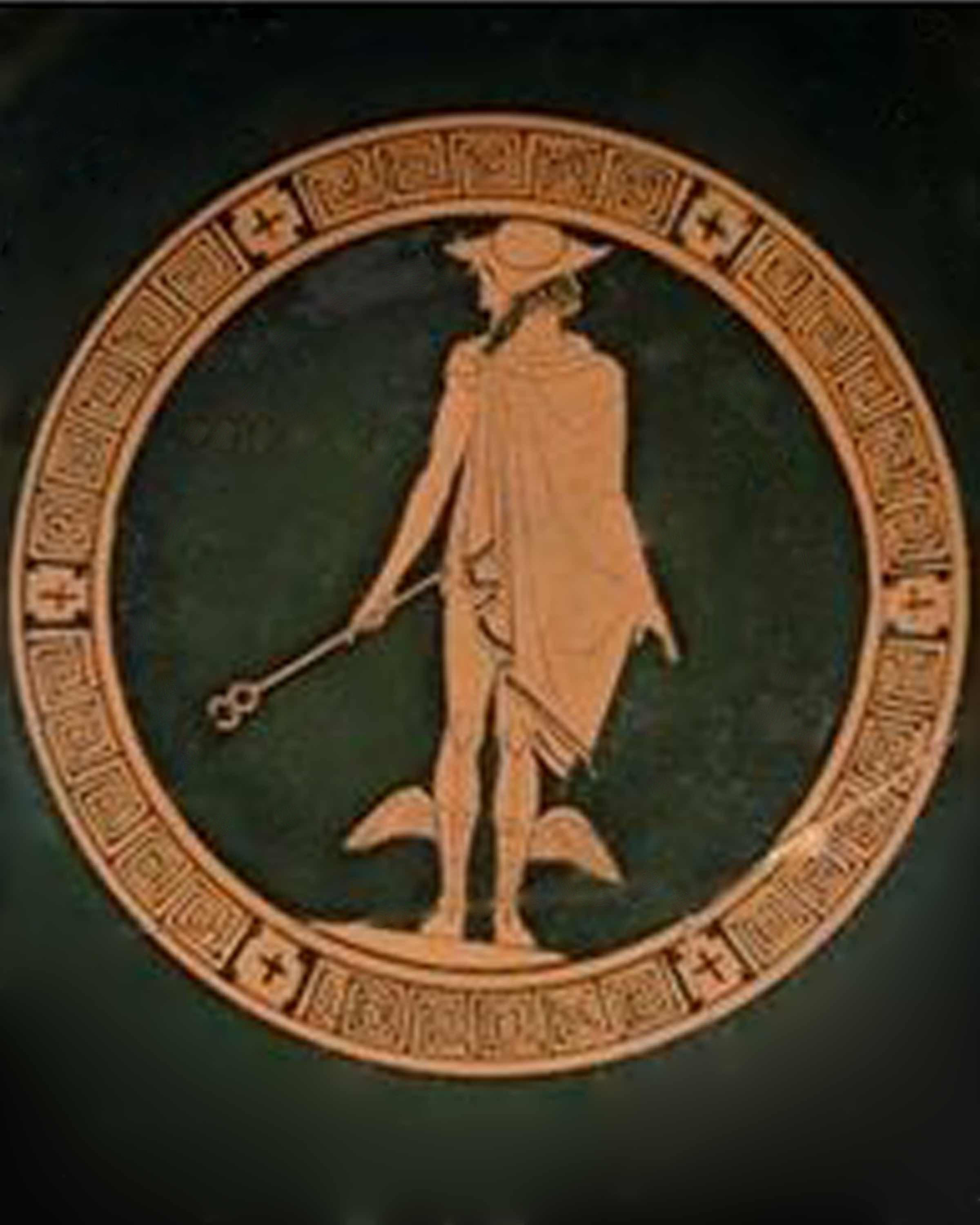
Inna Semetsky Inna.Semetsky@education.monash.edu.au
This paper is a sequel to my earlier article titled “Symbolism of the Tower as Abjection”, which was published in Parallax (Leeds University, UK) in 2000. The paper interpreted the symbolism inscribed in the imagery of “The Tower” card in a Tarot deck in terms of Julia Kristeva’s theory of abjection. The year after, in 2001, it was another striking image that shook the real world: the events on September 11 and the collapse of the World Trade Center's 'Twin Towers.' The start of the 21st Century happened to be marked by the conflict and catastrophe that represent, as this paper will argue, the dynamics of abjection. The Age of Abjection, as I call it, is permeated with the confrontation with the Law of the Father where a symbolic child risks not only castration but also the destruction and loss of its whole being. I am going to interpret the meaning of the Tower image at both textual (or rather pictorial, or semiotic) level and at the level of social reality. I will then suggest that, in accord with Kristeva’s semanalysis, the destructive moment is in fact embedded within a generative constructive process, which represents at once symbolic and real construction of collective subjectivity within a double process of negation and identification. Therefore the very same moment is a marker of not solely abjection but of hope, this metaphysical concept elucidated recently by a number of critical theorists, including Kristeva (2002) who called such a transformative change a joyful revolt. Semanalysis
Semanalysis is the term coined by Julia Kristeva in 1969. She however rarely used it as an individual term later on. As originally posited, semanalysis represents a synthesis of the apparently disparate disciplines: psychoanalysis, philosophy, logic, linguistics, and semiotics in general. Quite paradigmatically, it points to the central role of psychoanalysis, with its emphasis on interpretation of symbols and dreams, in semiotics. In fact semanalysis is a portmanteau word referring to both semiotics and psychoanalysis and therefore, as will be seen later, is especially potent for the purpose of this paper. According to Kristeva, the aim of semiotic analysis is the making of various formal models. We consider such a model to be a symbolic representation, that is, a certain system, the structure of which, according to Kristeva, is isomorphic or analogous to the structure of the system under study, the latter to be modeled or represented. Semiotics not only produces models, but also considers them to be its own object of research.
A central concept in semanalysis is the text, which however is to be understood broadly as not only verbal or linguistic, but as a trans-linguistic apparatus of productivity. The crucial feature of the text, according to Kristeva, is that it is not reduced to just representing or literally meaning the real. For Kristeva, the textual (or rather, intertextual) signification derives from the text’s not merely representing but transforming reality. The text dynamically captures reality at the moment of its non-closure. I would like to make it clear that the definition of the text can be ascribed to different modalities for as long as they serve a purpose of dialogic communication and fulfill a specific generative activity called by Kristeva a signifying practice. Thus, pictures as well as any cultural artifacts may be considered as texts, albeit extra-linguistic. The lengthy narratives can be composed by pictures because, sure enough, “pictures have a continuous structure [which] induces the reader to … read the picture as if it were a written text” (Posner 1989: 276).
A signifying practice, reading, and interpretation constitute the textual productivity. This Kristeva’s concept focuses on the dynamical character of the process of generative activity – productivity – rather than on some final actual product. This activity is understood as a process or work, however without any references to Marx’s social exchange. The concept of work is posited to be analogous to what, for example, Freud used to call dream-work. According to Kristeva, “Freud revealed production itself to be a process not of exchange (or use) or meaning (value) but of …permutation, which provides the very model for production. Freud therefore opens up the problematics of work as a particular semiotic system, as distinct from that of exchange” (quoted in Noth 1995: 323). Etymologically, the position of “analysis” in semanalysis points to decomposition or dissolution of the sign and the text alike, which leads, by virtue of the process of work, to the empirical discovery in practice of some deep and hidden dimensions of meaning.
In her famous “Revolution in Poetic Language” Kristeva (1984) further develops the psychoanalytic significance of semanalysis by specifically differentiating between two dimensions, the semiotic and the symbolic. Roughly, the former may be related to what Freud called primary process and the latter – to his secondary processes. The primary process expresses itself prelinguistically, at the level of drives and instincts; therefore, and by virtue of it being pre-symbolic, it constitutes the semiotic dimension. The non-verbal semiotic dimension precedes the symbolic (or linguistic) one; the two finding themselves related to each other dialectically. Following the example of Freud’s psychoanalytic “psycho-logic”, Kristeva posits a new dialectical logic of contradiction as a foundation for the signifying practice. The Hegelian dialectics with its logical operation of negation becomes a basis of any symbolic activity.
The dictionary definitions of “abject” and “abjection” are as follows: abjection
The meaning of abjection, as described by Kristeva in her “Powers of Horror: An Essay on Abjection” (1982), is “one of those violent, dark revolts of being, directed against a threat that seems to emanate from an exorbitant outside or inside, ejected beyond the scope of the possible, the tolerable, the thinkable” (1982: 1). We experience abjection as a spontaneous reaction that may manifest in a form of unspeakable horror, often expressed at a physical level as uncontrollable vomiting, when faced with a breakdown in meaning caused by the generic loss of a habitual distinction. When the distinction – it being either between subject and object, or self and other, or life and death, or any habitual opposites for that matter – is destroyed, then the abjection takes its place. Abjection preserves what existed at the archaic level of pre-objectal relationship, as Kristeva puts it, and within the extreme violence as a condition of a body becoming separated from another body so as to be! Corpse serves as a primary example, traumatically reminding us of our own finitude and materiality; but so does Auschwitz as a symbol of a particularly destructive, violent, and immoral event. The corpse indicates the breakdown of the distinction between subject and object, that is, a loss of the crucial factor in establishing self-identity: it therefore exemplifies the concept of abjection. Kristeva, describing abjection, uses the infinitive “to fall”, cadere in French, hence cadaver, the corpse:
“[M]y body extricates itself, as being alive, from that border. Such wastes drop so that I might live, until, from loss to loss, nothing remains in me and my entire body falls beyond the limit – cadere, cadaver. If dung signifies the other side of the border, the place where I am not and which permits me to be, the corpse, the most sickening of wastes, is a border that has encroached upon everything. ... ‘I’ is expelled” (Kristeva 1982: 3-4).
In the psychoanalytic tradition, abjection is linked to the image of the splitting mother thus to one's desire for separation, for becoming autonomous –accompanied as such by the contradictory feeling of the impossibility of performing this particular act. Kristeva imagines a child who throws up trying to cleanse himself so as to construct “his own territory, edged by abject” (1982: 5). It is an attempt to release the hold of the symbolic umbilical cord by means of the violent breaking away from the womb, as if guided by the logic of rejection, embedded in bodily structure. But because this body is the only and immediate life-world known by the “I”, the very act of the fall or separation leads to the subject becoming a jettisoned object in this process. That’s why Kristeva says, “it is no longer ‘I’ who expel, [but] “I” is expelled” (1982: 4). Kristeva borrows the notion of “the excluded” from Mary Douglas thereby affording abjection a greater, social dimension in terms of ritualistic prohibition based on binary coding and resulting in separation and segregation of gender, class, race, age, language, or culture.
Imagery
I had a paper published in 2000, that is a year prior to 9/11, in Parallax
(Leeds University, CCS). This paper was called “Symbolism of the Tower as
Abjection” (Semetsky 2000, 2001)
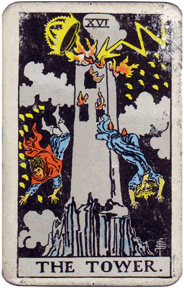
The year after, in 2001, it was another striking image that shook the real world: the tragic events on September 11. This is one of the images of the Twin Towers on 9/11 published on the Internet (Fig. 2):
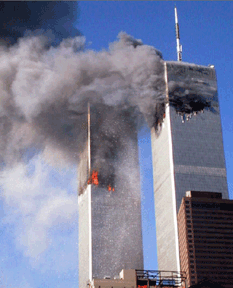
The beginning of the 21st Century has been marked by the catastrophe that may be described as a moment inscribed into what Kristeva called the dynamic of abjection, which was spreading from paganism through the whole of Western culture. The present Age of Abjection, as I want to call it, appears to be permeated with a confrontation with the law –symbolically, the Law of the Father – when a symbolic child risks not only castration but also the loss of its whole being. I am going to interpret the meaning of the Tower image with the help of Kristeva’s semanalysis, at both textual (or rather pictorial, or semiotic) level and at the level of social reality. I am going to suggest that, in accord with semanalysis, the destructive moment is in fact embedded within a generative constructive process, which represents at once symbolic and real construction of collective subjectivity within a double process of negation and identification. Therefore the very same moment is a marker of not solely abjection but of hope, this metaphysical concept elucidated recently by a number of critical theorists, including Kristeva (2002) who called such a transformative change a joyful revolt!
The picture of the Tower (Fig. 1), which is sometimes called The Tower of Destruction, is the sixteenth card in the twenty-two major arcana in a deck. The semiotics of The Tower card expresses one of the most dramatic, horrifying and powerful images in the deck: the two human figures are being thrown out of a tower struck by lightning. It is a fall, but not a free fall; it is a violent ejection. The figures' mouths are gaping in horror; their eyes look and see nothing. They are cast aside and far into the deep. The tower stands erect: it is only its crown that has been knocked down by the blazing flames caused by lightning. The two beings on the card have built the tower – and sealed it at the top; there is no entry or exit. They have imprisoned themselves in their own creation – the rigid, phallic, mental structure – and the only way out is through the agency of a threatening, violent breaking force that would necessarily bring along a traumatic, abject, experience. The two figures are neither subjects nor objects. In the midst of a crisis, they are in-between two categories, hence “beset by abjection” (Kristeva 1982: 1) when literally positioned between the two opposites of the symbolic sky and symbolic ground. Lightning pierces the sky above, and the ground below is ruined by earthquake. Or there is no ground at all: some decks portray a tempestuous sea. The violent fall from the tower, the feeling of the catastrophe amidst thunder and lightning, brings two figures, if I use Kristeva’s words, to the “border of [the] condition as a living being” (1982: 3)barely withstanding the effect of a rapid and shocking change. The falling bodies approach the limits of human endurance; they seem in their suffering to exist on the very border between life and death because in this fall “death [is] infecting life” (Kristeva 1982: 4).The fall appears to be infinite and may feel like eternity, signified by two figures caught up in a state of perpetual suspension, indeed within “the utmost of abjection”(Kristeva 1982: 4). The mood of this image is permeated with fear and uncertainty, confirming Kristeva’s claim that “abjection is above all ambiguity” (1982: 9). The sense of “perpetual danger”(1982: 9) and the unconscious anticipation of a shock, when the subject, the “I” – existing as “the twisted braid of affects and thoughts”(1982: 1) – will eventually have to hit the ground, makes the existence of the still alive “I” unbearable. This part of self that is “I”, is so desperate and feels overwhelmed to such an extent that it becomes greater than the self: an autonomous heavy body “which is dissociated, shattered into painful territories, parts larger than the whole” (Kristeva 1998: 152). The semiotics of the violent force is inscribed in the image of a sudden lightning; its effect is pre-symbolic (semiotic): it proceeds unconsciously and “draws me toward the place where meaning collapses” (Kristeva 1982: 2). This force becomes a sign of “the breaking down of a world that has erased its borders" (1982: 4). Signification, according to Kristeva, always functions as a fluctuation
between stability and instability, or static quality and the negation of a stasis.
Symbolic lightning from above, by breaking the order of things and so
negating the stasis of one’s identity within the existing order,
simultaneously illuminates the way to the new order and new identity, albeit
through abjection, an abject becoming an ambiguous sign, a deject, “a
tireless...stray” (Kristeva 1982: 8) situated in space specified as “essentially
divisible, foldable and catastrophic” (1982:8). The deject “never stops
demarcating the universe. …[It] has a sense of danger, of the loss that the
pseudo-object attracting him represents for him” (1982: 8). The Tower image
is an embodiment of ambivalence: at a deeper level, this card may be
identified with the Tower of Babel; in fact, it is portrayed in this manner in
some decks, like in The Lovers’ Tarot (Fig. 3)
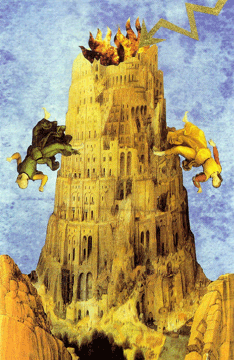
A sense of danger grows into the horror experienced by deject-abject when the inevitable force of the thunderbolt threatens the structure’s stability forcing the subject-abject to be driven to “a downfall that carries [it] along into the invisible and unnameable... Never is the ambivalence of drive more fearsome than in this beginning of otherness” (Kristeva 1997: 188). The semiotics of this image, an artefact, carries an uncanny resemblance to the other poignant and maximally real image of the destroyed towers (Fig. 4).
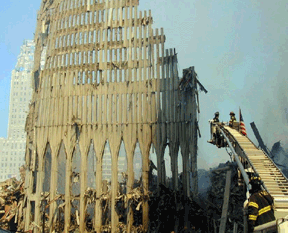
“The Tower” is a symbol of false omnipotence and mistaken certainty, a priori condemned to destruction during the most powerful and confusing instance of the collision of opposites and amidst persistent contradiction and mutual misunderstanding. Kristeva, speaking of contradiction, has stressed that its very conditions were “always to be understood as heterogeneity... when the loss of unity, the anchor of the process cuts in [and] the subject in process discovers itself as separated” (1998: 149). Indeed, the Tower becomes a signifier of a sudden interruption to the status quo of the state of affairs, it being either individual, or interpersonal, or collective and social. The loss of identity, experienced in abjection, prevents the figures on the picture from being able to envisage or recognize the moment of lightning. But the lightning strikes nevertheless even if the upcoming event stays out of the subject’s conscious awareness: indeed, “the impossible constitutes [the subject’s] very being” (Kristeva 1982: 5) and “a brutish suffering that ‘I’ puts up with” (1982: 2). Lightning may be identified with a sign of a sudden and totally overpowering change in one's psychic state leading to a potentially overwhelming (numinous?) alteration in consciousness. “A flash of lightning ...is discharged like thunder”, says Kristeva, as though herself peculiarly narrating the Tower picture, and “the time of abjection is double: a time of oblivion and thunder, of veiled infinity and the moment when revelation bursts forth” (Kristeva 1982: 9). In psychoanalytic terms, the Tower card may be considered to be an index of abreaction, taking the form of catharsis, that is, a dramatic and forceful replay of the unconscious material in consciousness, when indeed one’s “fortified castle begins to see its walls crumble” (1982: 48). However, the enforced evacuation, breaking all defences, frees one from being incarcerated in the symbolic tower of one’s own making, whether it be psychological, ideological, cultural, or any other stagnant belief system. The Tower card represents a structure that is sealed yet open: it is “an oxymoronic structure… an open/enclosure” (Casey 1997: 325), and it semiotically describes any unforeseen cataclysmic event, which suddenly brings people down to earth by disturbing the existing norm and order of things, while simultaneously – by expanding the boundaries of individual and collective consciousness – providing a set of conditions for a new order.
The change, via abjection, in the level of awareness represents dialectics that constitutes a double process of negation and affirmation that is embedded in the construction of identity. Negation is characterized by a temporary interruption in the periodic dynamic process, within which a pause appears, as claimed by Kristeva, in a form of a surplus of negativity, which would ultimately destroy the balance of opposites. That is why “the deject is in short a stray. ... And the more he strays, the more he is saved” (1982: 8), that is, constitution takes place via negation, ultimately contributing to the organization of reality at a new level. The breakdown in existing order simultaneously creates conditions for the potential production of a new order. Thus both rejection and stasis, or negation and identification, considered by Kristeva to be the essential elements of subjectivity, seem to precede the Lacanian mirror stage, providing that the mirror is taken metaphorically and not as solely predicated upon a pre-oedipal infant. This means that the dialectical process exists in its semiotic, quasi-objective reality prior to having become an object of recognition when presented in the form of the iconic sign (as “the Tower” card, for example). The function of the sign thus becomes to amplify the unconscious contents so as to eventually permit the “recognition of the want on which any being, meaning, language or desire is founded” (Kristeva 1982: 5). Kristeva, acknowledging the presence of the gap that exists between her analysands' verbal expressions and the affects perceived by the analyst, points to the loss of meaning in contemporary life due to dissociation between affects and language: the words are meaningless because the psyche is empty. But the unconscious contents projected in Tarot imagery indicate that the psyche is never really empty even if unconscious of itself: its contents are constituted by signs, which – never mind their existing prior to articulation – are semiotically real and informationally active because of their affective capacity to produce real effects. The pragmatics of interpreting Tarot images in terms of semanalysis is to carry the signs over to the level of conscious awareness, to articulate them into readable symbols so as to bridge the said gap by returning the meaning to its bearer. Kristeva emphasized “the working of imagination [in] the experience of the want” (1982: 5)that is, the realm which is virtual, non-visible and “logically preliminary to being and object” (1982: 5) that would find its signification in nothing but the spoken language. However, Tarot pictures carry that implicit semiotic signification, which appears prior to articulation in its iconic and indexical (cf. Peirce) mode. Respectively, this is signification of the higher order, or meta-signification founded upon interpretation when signs (semiotic) are being translated into words (symbolic), thereby trans-linguistically producing meanings within the very signifying practice of Tarot readings. Kristeva considered the affective world to be enigmatic for the reason of it being irreducible to the verbal mode of expression. All affects exist only through signs that stand for the “psychic representations of energy displacements.... [whose] exact status ...remains, in the present state of psychoanalytic and semiological theories, very vague. No conceptual framework in the relevant sciences... has proven adequate to account for this apparently very rudimentary representation, presign and prelanguage” (Kristeva 1997: 192). However, (and such is the thesis advanced earlier in Semetsky 2000), Tarot images when functioning in a mode of pictorial semiotics (cf. Sebeok 1994), do enable the shift of a subject-position from the infamous abstract view from nowhere to the contextual and concrete view from the here-and-now. Pictures function in the capacity of “a modality of significance” (Kristeva 1997: 193) for affects, moods and thoughts, which represent “inscriptions [or] energy disruptions... [that] become the communicable imprints of affective reality, perceptible to the reader” (1997: 193). Any semiotic system as part of the typology of cultures needs certain means for its identification within a field of communicative and social relations. Culture itself could be seen as a set of texts inscribed in collective memory (Lotman 1990), and texts, we repeat, need not be exclusively linguistic.
The symbolic Tower of Destruction may be erected not only at the individual level but also the collective one. In the feminist interpretation (Gearhart & Rennie, 1981), “The Tower” signifies radical intervention, revolution and the overthrowing of false consciousness, violent social conflict and change, destruction of the old order on a grand scale, and release from imprisonment in that patriarchal structure during the very process of its demolition. Jean Baudrillard (2002), in his analysis, or as he says, analogon, of the spirit of terrorism, talks about the shift of the struggle into the symbolic sphere where an initial event – “as quite a good illustration of chaos theory” (2002: 23) – becomes subjected to unforeseeable consequences. Such a singular event – like the destruction of Twin Towers on September 11 – propagates unpredictably, causing the chain of effects “not just in the direct economic, political, financial slump in the whole of the system –and the resulting moral and psychological downturn – but the slump in the value-system” per se (2002: 31-32). The collapse of the towers represents the fact that “the whole system has reached a critical mass which makes it vulnerable to any aggression” (2002: 33). Baudrillard points out that not only terrorism itself is blind but so were the real towers – “no longer opening to the outside world, but subject to artificial conditioning” (2002: 43): air conditioning, or mental conditioning alike, – similar to the Tower on the Tarot picture that was sealed at the top when suddenly struck by lightning. The collapse of symbolic Panopticon that was founded on the meticulous organization of space, generates chaos out of the former order: the abjection in this case loses its phobic quality, becoming not only the power of horror, as Kristeva says, but the power of terror. It turns instead into the unleashed rage of violence against violence when the long repressed emotions and implicit feelings concerning the state of affairs, when deprived of expression, explode and “spill out from their ... container” (Casey 1997: 323). No longer projected inward, the released violence becomes directed into the space where, ure enough, the abject “does not respect borders, positions, rules”(Kristeva 1982: 4). This is indeed “abjection [that] allows us to move beyond the Law of the Father” (Bogue & Cornis-Pope 1996: 10). In a sense, there is jouissance in this process: Kristeva states that subjects that are “victims of the abject are its fascinated victims” (1982: 9). Quite significant is the fact that the card immediately preceding “The Tower” in a deck is called “The Devil” (Fig. 5) and is traditionally interpreted in terms of fear, bondage, submissiveness, and sexual or economic dependency. 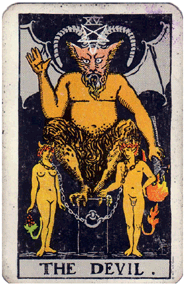
It represents the absence of freedom, the lack of hope, and the total powerlessness tending to, as Baudrillard would have said, crystallize and then, at the critical level, begin to spread spontaneously until reaching the climax. Non-incidentally, the subsequent card in the deck, “the Tower”, semiotically represents this climax as the utmost of abjection. At the level of depth psychology, the image of the Devil is the embodiment of the powerful, either individual or collective, Shadow that lurks behind the scenes and may indicate, very much in Nietzschean sense, the ultimate slave morality in the relationship between oppressor and oppressed, even if the interplay of forces involved in this interaction subsists at the unconscious level only. It represents a moment of psychological denial and a possible implementation of scapegoat policy, while projecting onto “the other” one’s own inferior and “shadowy” qualities. It is only when a set of relations becomes totally unbearable for the psyche, infusing it with fears and phobias, then the next symbol, the Tower, comes forward. Or, rather vice versa, when the effect produced by “The Tower” crosses over the boundary between the Symbolic and the Real, then the breaking down of the current status quo becomes unavoidable. Revolt against may turn into revolt for: ambiguity may lead to the appropriation of the other, that “Other who precedes and possesses me, and through such possession causes me to be” (Kristeva 1982: 10). Jouissance? Yes, but one that borders on a violent passion. The joy is highly problematic indeed: it is only jouissance for as long as the power is distributed properly. The joy of destruction, if over- determined, may contribute to erecting yet another Tower, to replacing one Symbolic Order with another. Baudrillard calls it a state of total control, a terror that is now based on law-and-order measures (2002: 32). However, the historicity is in the place and in place: it is so inscribed in the genealogy of space that any tower attracts lightning and is destined, sooner or later, to be blasted by a thunderbolt. The subject, if not in process, is spaced-out and, respectively, is out of place both symbolically and literally: “the space of the subject collapses in on itself and the subject without psychic space is prey to aggressive drives and paranoid projections of the kind exhibited in misogyny, nationalism, racism and war” (Kirkby 1998: 111). One's sealed world was initially created due to the presence of the primary, unconscious, and narcissistic desire to imprison oneself in the Tower. The image of expulsion from the Tower seems to be “the logical mode of this permanent aggressivity, and the possibility of its being positioned and thus renewed. Though destructive, a ‘death drive’, expulsion is also the mechanism of relaunching, of tension, of life” (Kristeva 1998: 144), that is, its function doubles to play a creative role in the construction of subjectivity and transformation of reality. The Tarot readings operate at the level analogous to semanalysis: the interpretation of the pictorial text leads to the subject’s identifying herself with the implicit meaning inscribed in the symbolism of the Tower and, respectively, becoming able to recognize her own shifting identity as abject. The subject, when functioning in the capacity of the abjective self, becomes animated by expulsion, by (so to speak) abjecting the abject in accord with the dialectics of negating the negation. As Kristeva points out, “such an identification facilitates control, on the part of the subject, a certain knowledge of the process, a certain relative arrest of its movement, all of which are the conditions for its renewal and are factors which prevent it from deteriorating into a pure void” (1998: 149), the ground zero. Thus, although the interpretation of the text when indeed “revelation bursts forth” (Kristeva 1982: 9) seems by itself to be a violent act, in a sense of its shattering one's set of privileged beliefs – such a violence of expulsion “rejects the effects of delay”(Kristeva 1998: 153) and hence – rather than breaking the subject – contributes to making the subject anew, to re-making it! For this reason, the image of “the Tower” card sometimes serves as a sign not of a breakdown but a breakthrough, albeit in both cases necessarily indicating the abruptly terminated current psychological state or a break-up in a set of values privileged by a given culture. Significantly, the polyvalence of the image that follows the Tower in a deck, “The Star” (Fig. 6) connotes the field of meanings which include healing, hope, inspiration, and creativity therefore semiotically transmitting the message that no destruction is final. In fact, this card is sometimes called this way: The Star of Hope. 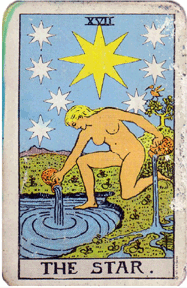
Analogously, Kristeva points to the possibility “of rebirth with and against abjection” (1982: 31) following catharsis represented by symbolism of “the Tower”. The semiotic significance of the iconic signs is justified by their functioning in the mode of a site of a subject-in-process who, “instead of sounding himself as to his ‘being’ …does so concerning his place: ‘Where am I?’ instead of 'Who am I?’ For the space that engrosses the deject, the excluded, is never one, nor homogeneous, nor totalizable, but essentially divisible, foldable and catastrophic” (1982: 8). This ambiguous space is called “a strange place, … a chora, a receptacle” (Kristeva 1982: 14):a subject-in-process being always already constituted by conflicting desires and perverse “drives, which are ‘energy’ charges as well as ‘psychical' marks’”(Kristeva 1984: 25) creating an enfolded field of forces in action that need to be unfolded in semanalysis. The term borrowed from Plato, chora's original meaning is a connective link between realms of the intelligible and the sensible, implying a quality of transition or passage, a bridge – albeit invisible and in itself formless — between the two. Chora is a site saturated by forces, itself a vital and “moving force” (Casey 1997: 324). Kristeva, acknowledging the dynamic and even organizing character of chora, as “a ... totality formed by the drives and their states in a motility that is as full of movement as it is regulated” (Kristeva 1984: 25), stresses its provisional and non-expressive quality within the limits of verbal discourse. In the mode of pictorial semiotics, however, chora becomes effectively expressive as the discursive boundaries expand to incorporate the non-verbal, extra-linguistic mode of the paradoxical “semiotic articulation” (Kristeva 1998: 142)) in the “language” of signs. On “the Tower” picture, a space occupied by the subject in process is unstable and ambivalent: the archaic divided self, by virtue of its very (dis)placement in the chora, is represented by “a multiplicity of ex-pulsions” (Kristeva 1998: 134), the primary function of which is self-destruction or the death drive. Still, it is an amorphous space, the rhythmicity of which resonates with the pulsations of labour when giving birth: ultimately, therefore, chora fulfils its generative and creative purpose, as represented by the figure of the naked woman in the “the Star” picture. Structure-less, chora can be designated solely by its function which is explicitly feminine: to engender, to provide the caring conditions – or rather, in its relational economy, to be the condition, the symbolic home – for regeneration, re-birth, and the genesis of new forms. In her recent interview with Mary Zournazi, Kristeva (2002) present hope as a transformative, humanistic, and even religious idea. Pointing to the destruction of psychic space in the current ideological climate, she says that our hope for a positive and “joyful revolt” (Kristeva 2002: 64), that is, a transformation in our critical thinking up to the point of inventing new ways of living – is embedded in the economy of care. Care, as a type of psychoanalytic cure, is “a concern for others, and a consideration for their ‘ill-being’”(2002: 66). The loss of hope is what is feeding terror, and it was precisely on September 11, 2001, when Kristeva re-defined her idea of revolt as event enabling one to move into a space of hope. She calls it a process of re-evaluation of the psyche that constitutes the renewal of the self, which embodies events that she calls “symbolic mutations” (2002: 76). The fall of Berlin Wall, or the drama of the Russian Kursk, or the planes hitting the World Trade Centre, natural disasters like earthquakes and hurricanes notwithstanding – those singular events may provide experiential conditions for transformation. The very “logic of symbolic change” (2002: 75) presupposes “necessity of the symbolic deconstruction, the symbolic renewal, which comes from creation – psychic creation, aesthetic creation, rebirth of the individual” (2002:76). Such deconstruction enables the expansion of consciousness in terms of healing, hope, and the flow of creativity, all these attributes represented by the imagery of “the Star”. The semiotics of pictures creates their own text, the semanalysis of which provides those “other means, symbolic or imaginary”(Kristeva 1997: 391) that serve as an example of the economy of care and hope in the aftermath of destruction.
References
Baudrillard, J. (2002). The Spirit of Terrorism and Requiem for Twin Towers (C. Turner, trans.). London: Verso.
Bogue, R. & Cornie-Pope, M (eds) (1996). Violence and mediation in contemporary culture. Albany SUNY Press.
Casey, E. (1997). The fate of place: a philosophical history. Berkeley and Los Angeles: University of California Press.
Gearheart, S. & s. Rennie (1981). A Feminist Tarot. Persephone Press.
Kirkby, J. (1998). Julia Kristeva: A politics of the inner life? In J. Lechte & M. Zournazi (Eds), After the revolution: On Kristeva. Australia: Artspace Visual Arts Center, pp.109-123.
Kristeva, J (1982). Powers of Horror: An essay on abjection (L.S. Roudiez, trans.). New York: Columbia University Press.
Kristeva, J (1984). Revolution in poetic language (m. Walter, trans.). New York: Columbia University Press.
Kristeva, J. (1997). Black Sun. In K. Oliver (Ed.). The portable Kristeva. New York: Columbia University Press, pp. 180-202.
Kristeva, J. (1998). The subject in process. In P.ffrench and R.-F. Lack (Eds.) The Tel Quel Reader. London and New York: Routledge, pp. 133-178.
Kristeva, J. (2002). Joyful Revolt. In M. Zournazi, Hope: new philosophies for change. Australia: Pluto Press, pp.64-77.
Lotman, Y. (1990). Universe of the Mind: a Semiotic Theory of Culture, trans. A. Shukman. Bloomington: Indiana University Press.
Nöth, W. (1995). Handbook of Semiotics. (Advances in Semiotics). Bloomington: Indiana University Press.
Posner, R. (1989). What is culture? Toward a semiotic explication of anthropological concepts. In The Nature of Culture: Proceedings of the International and Interdisciplinary Symposium, October 7-11, 1986 in Bochum. Walter A. Koch (ed), pp. 240-295. Bochum: Brockmeyer.
Sebeok, T (Ed.) (1994). Encyclopedic Dictionary of Semiotics (Approaches to Semiotics, 73). New York: Mouton de Gruyter. 
E-mail the editors Pour écrire à la rédaction © 2005, Applied Semiotics / Sémiotique appliquée |
Headline 3
insert content here
